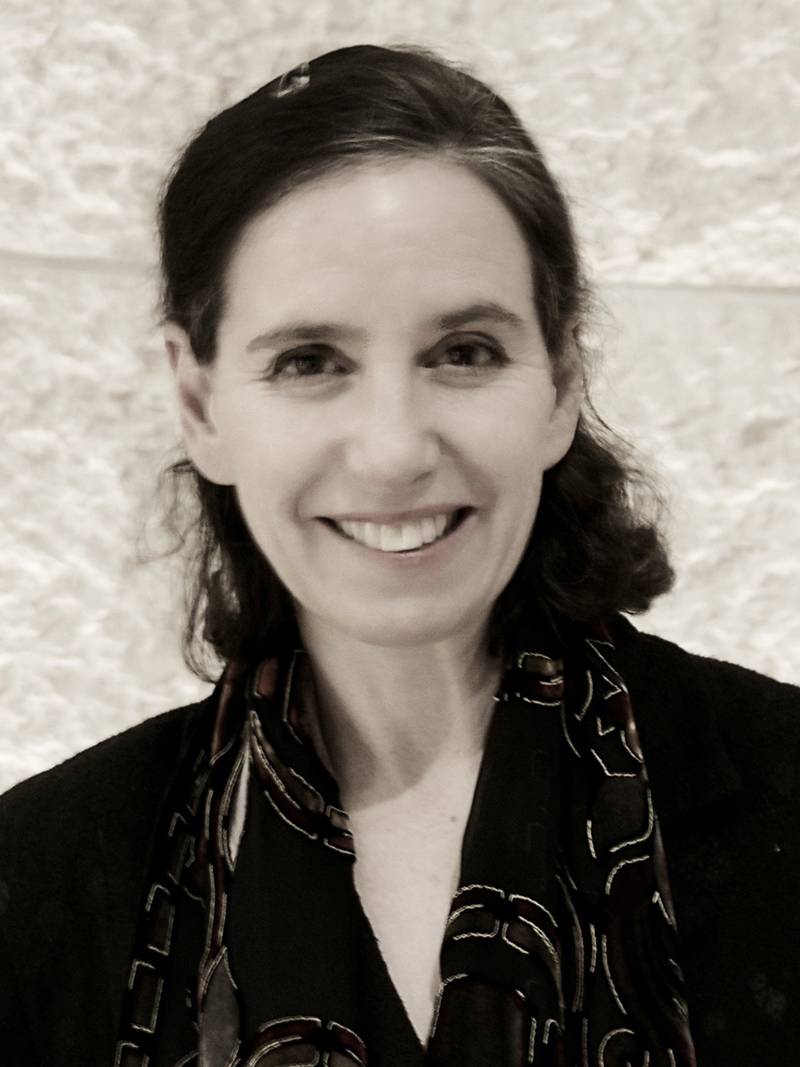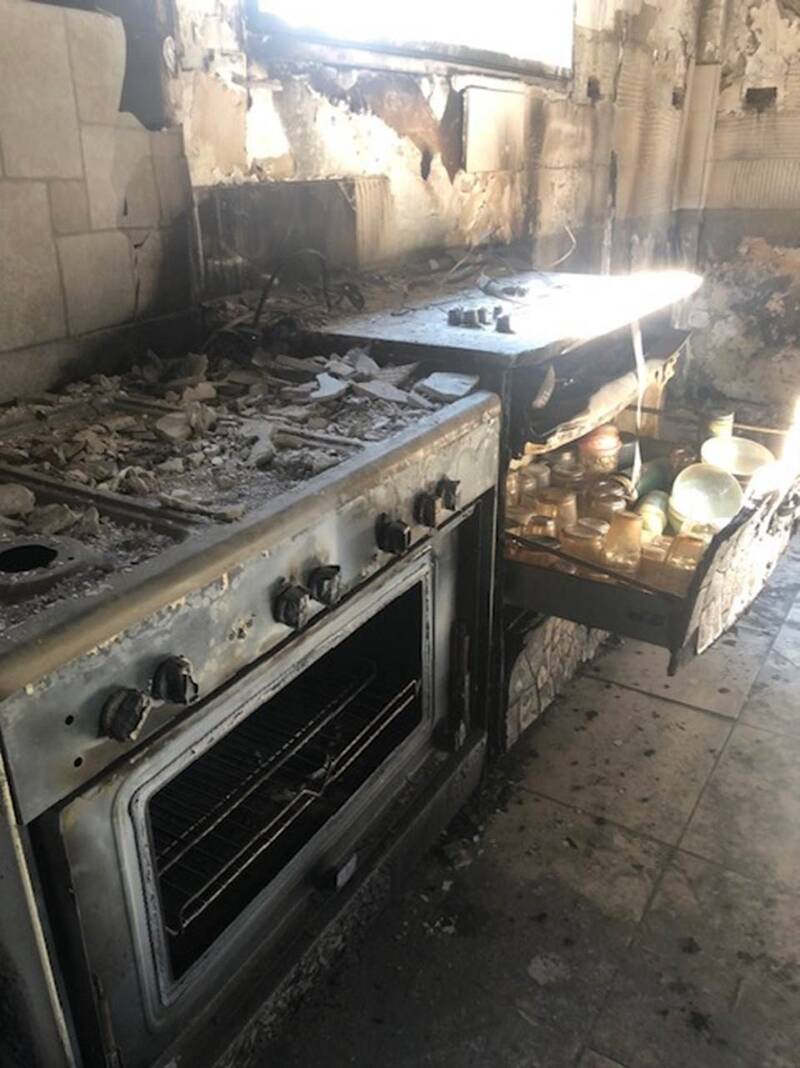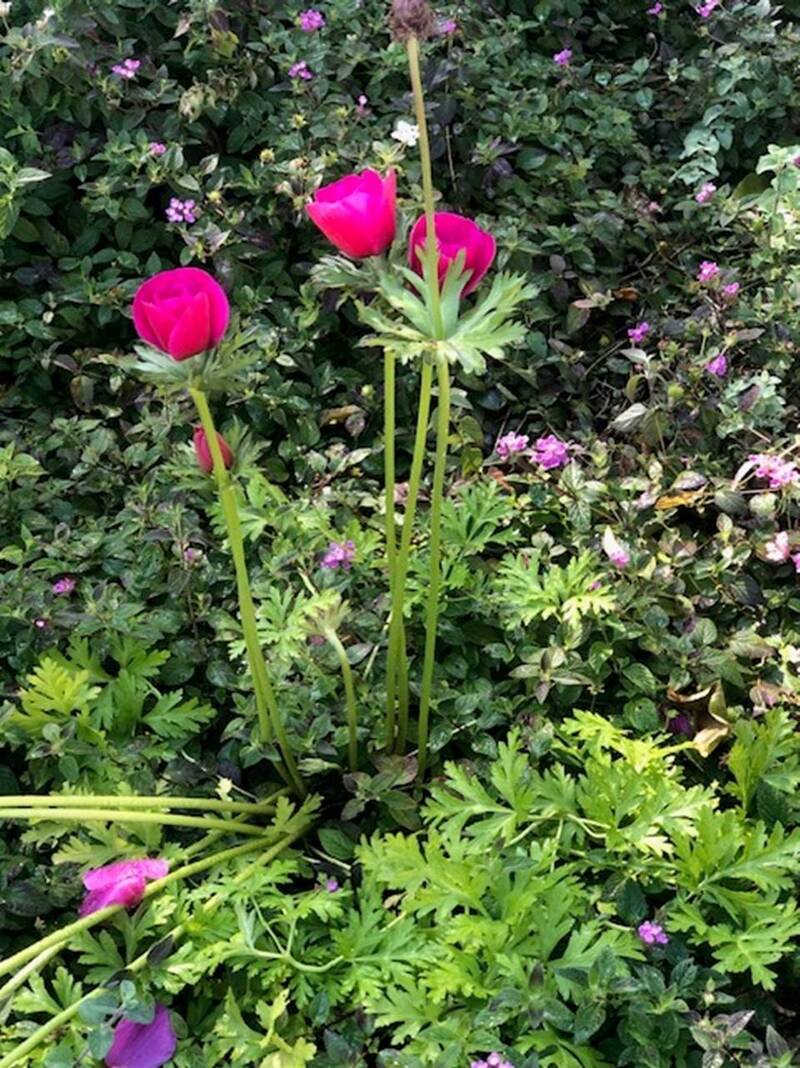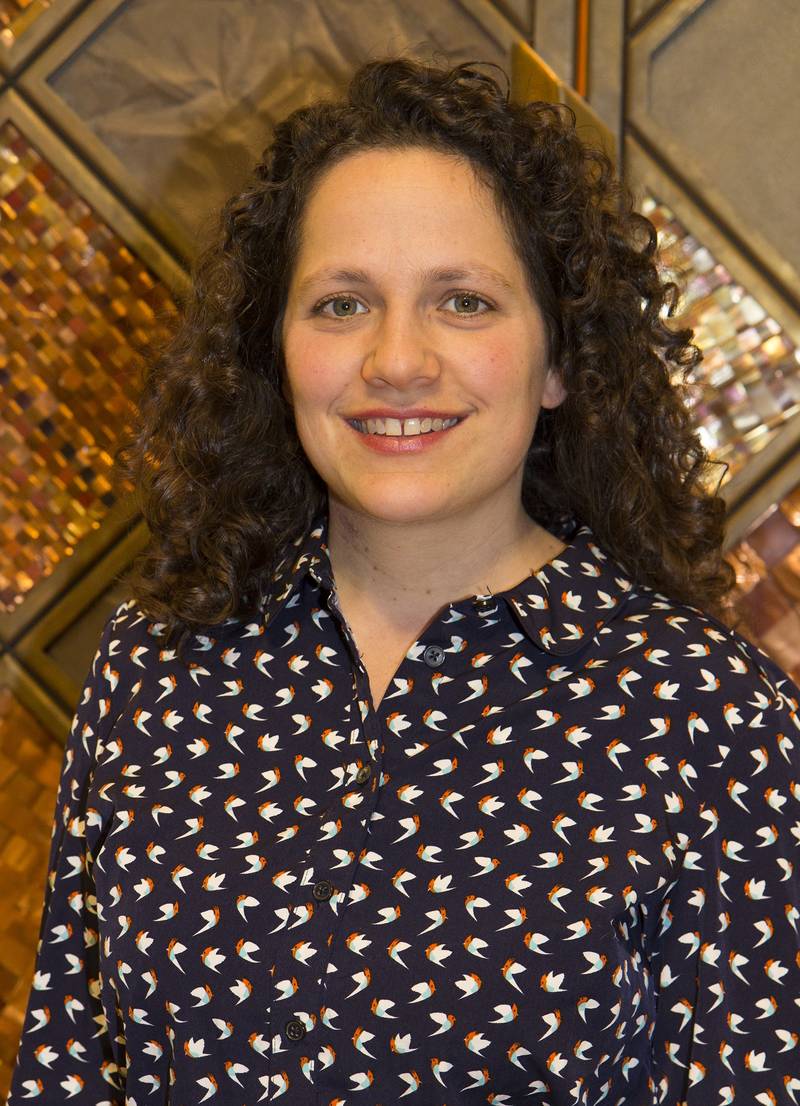TFTW Archive 2024 March

Shabbat Ki Tissa 
1 March 2024
Dear Members and Friends,
It is Spring in Israel. What you notice on the drive south towards Nir Oz, one of the kibbutzim where a quarter of its 400 residents were murdered or taken hostage, its houses and communal buildings utterly devastated by Hamas terrorists on October 7th, is the luxuriance and green of the fields, peppered with wild flowers – kalaniyot (anemones), rakefet (cyclamen) and narkis (narcissus). There is an ethereal beauty here that is suffused by the radiance of the light. And this dissonance of beauty and brutality has remained with us throughout our visit to Israel.
We are welcomed by Irit, a slight woman and her dog Bon Bon. It is my first day in Israel and I am with a group of rabbinic colleagues from the Liberal and Reform movements for three days of to meet with survivors of the October 7 massacre, with the families of hostages still held, and Israeli colleagues.
Nir Oz – the name means ‘meadow of strength’ – was founded in 1955 and lies less than two miles from the Gaza border. It is designated as one of Israel’s most beautiful kibbutzim and its botanical garden is distinguished by a variety of trees, flowers and plants that grow there. The trees, planted when the kibbutz was first founded, form an avenue of shade along the pathways from small concrete homes to the communal living areas – the kindergarten and dining room. Its beauty and peacefulness on this late February morning belie the chaos and carnage of what we are about to witness here and have read about in Gaza.
Irit leads us into her one-storey house which is near the entrance to the kibbutz. She ushers us into her ‘safe room’, the shelter that every home on the kibbutz has, part of the house, but made of reinforced concrete and with a metal shutter to close over the windows. They are designed to withstand rocket attacks, but not armed incursions, Irit explains. She closes the door behind us. The room is small; she uses it as her study and there are books on the shelves. The door is not lockable, deliberately so, she explains, and when she and her 22 year old daughter took refuge in the shelter on the morning of October 7th, hundreds of terrorists had infiltrated the kibbutz and were rampaging their way through every single home, stealing, shooting and setting fire or throwing grenades inside the houses. A silversmith and jewellery maker, Irit quickly put together an old oar from a boat that had belonged to her father and a tube from the vacuum cleaner, bound these together with wire and wedged the door so that it could not be opened. Then, taking the books off the shelves and building a wall around the table, she and her daughter hid underneath it for twelve long hours as the terrorists repeatedly came back into the house and tried to gain entrance, but failed.
It is difficult to imagine the terror these two women experienced as they waited for the army to come and rescue them. And even when they arrived twelve hours later, the women did not emerge until they were convinced that the men outside their door were from the IDF and not Hamas terrorists.
As we emerge from the shelter, she points to the bullet hole in the floor of her living room. Now you see it is clean, she says, we spent a long time clearing it up. She leads us down the paths of the kibbutz, pointing out the houses of neighbours, and telling their stories – stories are hard to listen to – Sagui Dekel Chen, kibbutz first responder, kidnapped; Ohad Yahalomi, shot and assumed dead, his wife Bat Sheva and three children, aged twelve, eight and a baby, all forced on to a moped and taken towards Gaza. At some point, Bat Sheva and the younger two children managed to escape, but Eitan, the eldest was abducted and released on November 27th. Oded Lifschitz, a retired journalist, 83 years old and his wife Yocheved, both abducted, Yocheved released at the end of October 2023. Each burnt out shell of a house tells its own story.
The western end of the kibbutz takes us into the heart of darkness. Bullet holes riddle the outer and inner walls of each house and the glass doors of the dining room are shattered, its completely kitchen burnt. There are no words to describe the destruction of each house: blackened, soot covered walls, twisted steel girders that have come away from the walls and ceiling, buckled roofs and walls, children’s toys and clothes, books and other belongings strewn on the ground, blackened by smoke, doorways and glassless windows staring blindly out on to the little courtyards, with upturned children’s toys, stacked plastic chairs that have melted into each other and piles of ashes.
On the noticeboard in the dining room entrance are pictures of the eleven Thai workers who were killed or abducted and the post boxes for each household with red stickers over the names of those who had been killed, black for those who had been taken hostage. A memorial to those who have been lost and who may or may not be still alive.
Broken glass crunches under our shoes. In one house an upright piano has been smashed and burnt beyond recognition, and the ruined remains of a saxophone lie on the floor.
I came to Israel to be present for people like Irit and to meet some of the families of the hostages and to listen to their stories. These will have to be for another time. I come away deeply humbled by the gratitude of all those I have met – Irit, Amir Tibon, the journalist who was rescued by his father from Nachal Oz, another kibbutz in the Gaza envelope, our Israeli colleagues who have been burying the dead and supporting evacuees, and the gentleness and grace of the families of those who have been abducted by Hamas.
Again and again, Israelis said to us: they [the Palestinians] are not going to disappear, and we are not going to disappear.’ ‘We don’t have guns, tanks or missiles,’ said Elad, the brother of Dror who has been missing since October 7th and is believed to have been taken hostage. ‘My politics don’t really matter, all we are asking for is solidarity. I want to live in a place where people’s lives have value.’
As we climb back on to our minibus, leaving behind a kibbutz now empty of its inhabitants – people who wanted to live in peace with their neighbours, volunteers who would drive Palestinians to their medical appointments from the border to hospitals in Israel – I am reminded of the words spoken by Sir Anish Kapoor on Kristallnacht in 2021 at the LJS:
‘We human beings hold within us a deep beauty and deep violence. Beauty is around us at every moment and yet somehow, we too often fail to see it, or cannot allow ourselves to see it. Violence is with us as a constant. Violence is inarticulate, unspoken, or unrecognized known. Violence sits within us waiting to pounce, it readily finds voice in collective acts of horror, political and communal… beauty and violence are in a psychic continuum.’
To be an indirect witness to this inarticulate brutality and violence, to the extreme cruelty perpetrated, is to see it as through a glass darkly, obscurely, a source of our bewilderment, sadness and rage.
But that heart of darkness, paradoxically, has the power to awaken our compassion and to open our eyes to the beauty around us. We leave the kibbutz with the images of those burned and twisted girders and the tragedy of murdered children and parents, carers and workers, but also with an image of beauty, of three poppy anemones growing opposite Irit’s house – their silky rose coloured petals emerging from a green ruff surrounding their slender stalks.
There is more to write about, but for now, I wish you Shabbat Shalom from the peaceful hills of En Kerem just outside Jerusalem.
Alexandra Wright


When The Month of Adar Begins, We Increase Joy.
1 March 2024
Dear Members and Friends,
Jewish festivals give structure and meaning to our lives. Each of them raises dilemmas and asks important questions. On Yom Kippur, we speak about repentance and ask for forgiveness; on Passover, we reflect on the meaning and reality of freedom. The next festival we will celebrate soon is Purim. Rabbis of the Talmud commanded us to increase our happiness at the beginning of the Hebrew month of Adar, the month when we celebrate this festival:
משנכנס אדר מרבין בשמחה
As soon as the Month of Adar has started, we increase joy.
(Taanit 29a)
The first day of the Hebrew month of Adar II will begin on Monday, but many people might not feel joyful this year. We approach Purim with so much tension in the world, so it might feel inappropriate to have a joyful celebration and Purim masquerade. Nevertheless, Purim has a lot to teach us this year.
Rabbis connected Purim with Yom Kippur because of the linguistic similarity between the names of the festivals. Yom Kippur can be read as Yom Ke-Purim, meaning "a day like Purim". This suggests that both days share a common theme of repentance and redemption, albeit in different ways. On Yom Kippur, Jews fast and pray to atone for their sins and receive forgiveness, while on Purim, Jews celebrate their deliverance from evil by feasting and rejoicing. Jewish mystical tradition explains this unlikely link this way:
It is called Purim because, in the future, people will rejoice on Yom Kippur and transform its required afflictions into delight. (Tikkunei Zohar 57b:4)
The ability to transform, change and repent links Purim to Yom Kippur. On Purim, the fate of the Jewish people was reversed and turned into prosperity. It is similar to Yom Kippur because, on that day, we try to redirect the trajectory of our lives and change our behaviour. Therefore, we hope that the world will be transformed one day with nothing to repent, so the Day of Atonement will become the day of joy and celebration.
This year, I suggest that this pairing may work the other way around. Purim’s story of redemption and joyful victory should become the story of deep reflection and asking for forgiveness. We must go through deep self-reflection to win the battle against the external enemy.
What can we do to transform the atmosphere of tensions, wars and endless conflicts into something positive? I don’t know what needs to happen, but I know our ancestors did it. People in the past went through the most horrific nightmares, but they found the strength to overcome them and celebrate life. The Festival of Purim came out of an existential threat to Persian Jews. The Festival of Pesach is the outcome of the liberation from slavery. So far, at the end of each war, there was peace, all tyrants and dictators died or were overthrown, and all oppressive empires of the past ended. The time for Passover’s Freedom will come, but now is the time for Purim’s grotesque comedy and drama. Therefore, we must never lose hope and always believe that a new transformation is possible; we need to keep trying and keep our hope alive.
Shabbat Shalom,
Rabbi Igor
Shabbat P'kudey
15 March 2024
Dear Members and Friends,
This is a strange year. The world beyond our own Jewish world is preparing for Easter and holidays at the end of this month, yet we, in the Jewish community, are yet to celebrate Purim, let alone Pesach. In this leap year, when an additional month has been added or ‘intercalated’, to use the technical term, into the calendar, we must wait an extra month to read Megillat Ester, the Book of Esther – the book that tells the story of how Esther saved her people by pleading with her husband to reverse a cruel and genocidal decree against the Jews of Persia.
It was for plausible reasons that Purim was abolished by the founders of Liberal Judaism. Even the words of Esther could not persuade them to remind us of the catastrophes that had beset the Jewish people throughout the ages:
‘For how can I bear to see the disaster which will befall my people! And how can I bear to see the destruction of my kindred’ (Esther 8:6).
It was not because they did not want to recap past tragedies or remember the Hamans of Greek or Roman empires, the Crusades or Cossack pogroms in Eastern Europe. The devastation and destruction of the Shoah had yet to befall our people.
Nor was it because of the imaginary, fictional nature of the book with its caricatures and parodies, its sending up of the Persian court and laws.
No, it was because of the closing chapters of the Book of Esther in which the king, Achashverosh, permits the Jews of every city ‘to assemble and fight for their lives,’ to defend themselves against any people or province who attack them, and ‘destroy, massacre, and exterminate its armed force together with women and children, and plunder their possessions’ (8:11).
It was because of the document that was to be issued as a law in every single province throughout Persia, to be publicly displayed to all the peoples, ‘that the Jews should be ready for that day to avenge themselves on their enemies’ (8:13).
It was because ‘no one could withstand [the Jews], for the fear of them had fallen upon all the peoples,’ because they ‘struck at their enemies with the sword, slaying and destroying; they wreaked their will upon their enemies’ (9:5).
It is impossible to read the Book of Esther at this moment in time in the carnivalesque, mocking, satirical context that was intended by its author – as an overblown parody of Persian culture. There can be no gleeful gloating over our enemies, fictional or not. For this is a book written for Jews without sovereign power, subject to the rule of powerful, tyrannical empires. This is not a book for Jews to take to heart today, for its story of revenge is too close and too painful to our current truths.
To hear Israeli public figures speak this week of the ferocity of Israel’s response in Gaza, the destruction of civilian infrastructures, the terrible ‘collateral damage’, the ‘abandonment of any sense of shame and embarrassment’; to be told of the constant settler violence against vulnerable Palestinian communities on the West Bank, and the dangerous dream of Israeli supremacy among the far right, an ‘agenda of Armageddon’ – was more frightening than anything I have heard or read in the last five months since October 7.
Even if a Palestinian state were created tomorrow, said one of the speakers, the Jewish State and the Jewish people would still have to live with the destruction of this war and serious crimes against the innocent civilians of Gaza.
In the cabaret of Esther, we are left with one question. After the Jews of Persia had avenged their enemies, how was it possible for calm to be restored; for an ordinance of ‘equity and honesty’ to be observed throughout the kingdom; for Mordechai the Jew to be regarded with honour, ‘seeking the good of his people and interceding for the welfare of all his kindred’ (10.3)?
I am asking myself, how was that possible? How might it become a possibility for now, for the future? If freedom and independence are a vehicle to human rights, how can we, here in the UK, empower the individuals and institutions in Israel that are defending those values with their life?
Shabbat Shalom,
Alexandra Wright
Discovering Our Inner Courage: Esther's Journey of Vulnerability
22 March 2024
Dear Members and Friends,
Recently I read Brene Brown’s bestselling book ‘Rising Strong’ about the transformation that can happen when we allow ourselves to reset. Brown details the impact one can have by having emotional literacy and writing their own story. It felt very timely reading her book as the narrative arc of Esther seemed the perfect case study. As we celebrate the joyous festival of Purim, the story of Esther reminds us of the power of vulnerability, authenticity, and the human capacity for transformation.
When we first encounter Esther in the biblical text, she is an orphan taken in by her cousin Mordechai. Her given name, Hadassah, means "myrtle" – a humble shrub often overshadowed by grander plants. Yet, within this unassuming young woman lies a wellspring of inner strength and moral courage.
As the narrative unfolds, Esther finds herself thrust into the unlikely role of queen to the Persian King Ahasuerus. Facing the grave threat of genocide against her people, she must make the daring choice to "show up and be seen" before the king, risking her life in the process.
In this pivotal moment, Esther embraces vulnerability, shedding the protective layers of her identity and revealing her true self. "I will go to the king," she declares, "though it is against the law. And if I perish, I perish" (Esther 4:16). Esther (which in Hebrew means hidden) removes her mask and shares with King Ahasuerus that she is Jewish, and in so doing she saves her people. This act of profound vulnerability is not born of recklessness but of a deep sense of purpose and a willingness to be truly seen.
Brown writes, "Vulnerability is not winning or losing; it's having the courage to show up and be seen when we have no control over the outcome." Brene Brown reminds us that vulnerability is not a state of weakness but rather "the birthplace of love, belonging, joy, courage, empathy, and creativity."
Through her courageous actions, Esther not only averts tragedy but also discovers her authentic voice and power. She confronts the king with the truth of Haman's wicked plot, advocating for her people with unwavering conviction. In doing so, she reclaims her identity as Hadassah, the humble myrtle that defies expectations and blossoms into a force for good.
Esther's journey teaches us that vulnerability is not a destination but a continuous practice of showing up, being seen, and living wholeheartedly. Like Esther, we all face moments when we must summon the courage to step into the arena of risk, to shed the facades that constrain us, and to embrace our authentic selves. In short, to remove our masks of comfort and risk being truly seen.
As we revel in the festivities of Purim, let us draw inspiration from Esther. May her story remind us that within each of us lies the potential for extraordinary courage, resilience, and transformation.
Chag Purim Sameach – Happy Purim!
Shabbat Tzav/Parah 
29 March 2024
Dear Members and Friends,
I am beginning to think that there is nothing we can do to address the monumental crises of our age. How can we prevent our planet from hurtling towards destruction? How can we stop war? How can we bring an end to famine and hunger, to cruelty and violence? How can we free the hostages who have been held in Gaza for nearly six months? What kind of power do we think we have when we speak out against injustice or cry out for freedom and peace?
Sometimes it feels as though we have reached the end of history, that we have entered a dark apocalyptic era, a stalemate in which there is a profound sense of heartbreak and despair.
And yet can we really lose hope, can we give up the incremental steps required in our lives to seek something better? This week I receive an email from an unknown sixteen-year-old. She writes:
‘I was given the task by my school to create a piece on what Jews believe about the afterlife and while I understand that most place their focus on being a good person for the sake of being good, the afterlife is still a subject I would like to explore with these questions.’
She wants to know what Liberal Jews believe about the afterlife. A fair and interesting question. But she also asks whether we believe in gilgul (reincarnation), or Sheol, the biblical underworld, or Gehenna, a place of punishment and purgation, or Gan Eden (the Garden of Eden). My Liberal Jewish hackles rise a little, together with a creeping sense of cynicism. She asks whether a person’s perception of the afterlife would differ depending on whether ‘they are wicked or moral.’
I catch myself. A young woman is asking me to engage with aspects of our Jewish tradition, with belief and mysticism, with metaphysics. Yet, at the same time, she is asking what it means to be a good person or to stray from the path? Isn’t that the question asked constantly by the prophetic voices of our tradition? Perhaps it is linked to these other questions she presents.
Is it absurd for Liberal Jews to entertain the idea of an afterlife? After all, didn’t the belief in the olam ha-ba- the world to come - and the entire eschatological drama emerge during catastrophic times of upheaval in our Jewish history?
And perhaps similarly the mystical idea of gilgul – the ‘spinning’ of souls through thousands of generations - could the idea of the transmigration of the soul encourage us to live better lives in some way? What can this mean for us – anything? What if gilgul isn’t the reincarnation of our souls in another body, but how we awaken each morning, life restored, with the hope and possibility that this day will bring renewal, hope and better news?
What if Sheol and Gehinna are not the biblical or rabbinic ideas of a dark underworld, a place where we are ‘cut off’ from all existence, where we are punished for our deeds, but these dark moments of disruption in our people’s history, or times of sadness and depression in our own personal lives, when meaning departs, when we lose our vision of beauty and love and gratitude. What if Gan Eden, is not that mythical garden of Eden inhabited by Adam and Eve, but the places and times in our own lives when we have felt profound fulfilment and peace?
Is it too dangerous to recall the rabbinic framework that sees sorrow, grief and troubles increase in the era before the Messiah will come? Can war be the beginning of redemption, in the words of the Talmud (bSanhedrin 97a), or are these expressions simply vain hopes, empty expressions of comfort to a people in exile, fearful of their own humiliation and existence?
The Messiah is not a person; there will be no intervention in history from some extraordinary individual who will lift us out of our misery and bring about our redemption. Nor is the messianic age a destination on our journey through life, at some point in the future. We can no longer understand these terms in this way.
Perhaps these ancient terms can sustain different interpretations. They are not futuristic, but part of the landscape around us. Yes, war, hunger, deprivation of freedom, cruelty and violation. But they are also moments of still beauty. Early morning intimations of spring in the trees and birdsong, the suffusion of colour into the landscape around us, the friendship and hope that sustain us. We look for the light, for what we can do for others in small, but significant ways to make lives more bearable, little moments of blessings and peace in the here and now.
Shabbat Shalom,
Alexandra Wright
Mon, 27 October 2025
5 Cheshvan 5786
Return...

that you inform the office and bring a valid photo ID.
Privacy Settings | Privacy Policy | Member Terms
©2025 All rights reserved. Find out more about ShulCloud
